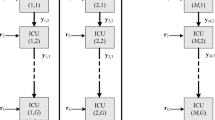Abstract
Recently, a number of projected successive interference cancellation (PSIC) and projected parallel interference cancellation (PPIC) structures, which make use of the non-negativity constraint in incoherent OCDMA systems to enhance their performance, have been proposed and studied in (Seleem et al. in IEEE Commun Lett 16:1721–1724, 2012). Although these structures showed improved performance, they still inherit the same shortcomings of the conventional SIC/PIC structures such as large detection delay for the SIC detector and slow convergence speed for the PIC detector. In this work, we propose a new projected block-wise SIC (PBSIC) structure that not only exploits the non-negativity constraint but also overcomes the drawbacks associated with the conventional SIC/PIC structures. In particular, it largely reduces the detection delay of the PSIC detector of (Seleem et al. in IEEE Commun Lett 16:1721–1724, 2012), while it enjoys the same fast convergence speed. Two approaches for decreasing the computational complexity of the proposed detector are investigated. Simulation results are in total agreement with our theoretical findings.








Similar content being viewed by others
Notes
A flop stands for floating point operation. Operations such as addition, multiplication, subtraction, division and compare are considered as one flop.
Abbreviations
- K :
-
is the number of users.
- k :
-
is the user index and it goes from1 to K.
- W :
-
is the number of data symbols in each processing window.
- w :
-
is the symbol index of the symbols in one sliding window interval and it goes from 1 to W.
- k’ :
-
is the effective user index and it goes from 1 to WK.
- N :
-
is the processing gain.
- n :
-
is the chip index and it goes from 1 to N.
- M :
-
is the number of data symbols.
- m :
-
is the symbol index and it goes from 1 to M.
- G :
-
is the number of blocks in a data packet.
- B :
-
is the number of blocks in a data packet.
- b :
-
is the block index and it goes from 1 to B.
- PW:
-
length of each processing window (in chips).
- V :
-
the overlap (in chips) between blocks in a data packet.
- τ k :
-
is the relative delay of the kth user.
- T t :
-
is a circular shift operator and it circularly shifts the rows of a matrix downward t rows.
- \({\overline{\mathbf{s}}}_{k}\) :
-
is the {N -by-1} spreading code of the kth user.
References
Kitayama, K.: Optical code division multiple access — a practical perspective. Cambridge University Press, Cambridge (2014)
Mutafungwa, E.: Comparative analysis of the traffic performance of fiber-impairment limited WDM and hybrid OCDM/WDM networks. Photon Netw. Commun. 13(1), 53–66 (2007)
Bhanja, U., Panda, S.: Comparison of novel coding techniques for a fixed wavelength hopping SAC-OCDMA. Photon Netw. Commun. 33(2), 179–193 (2017)
Hadi, M., Pakravan, M.R.: Analysis and design of adaptive OCDMA passive optical networks. J. Lightwave Technol. 35, 2853–2863 (2017)
V. Geetha and B. Manoharan, "Combined modulation and code design approach for MAI canelation in OCDMA system," 2015 2nd International Conference on Electronics and Communication Systems (ICECS), Coimbatore, 2015, pp. 520–524.
Michael l. Hoing, “Advances in Multiuser Detection” john wiley and sons 2009
Verdú, S.: Multiuser detection. Cambridge University Press, New York (1998)
K. Biteur and M. Kandouci, "Successive interference cancellation receiver (SIC) in DS-OCDMA system," 2012 24th International Conference on Microelectronics (ICM), Algiers, 2012, pp. 1–4.
Mrabet, H., Dayoub, I., Attia, R., Haxha, S.: Performance Improving of OCDMA system using 2-D optical codes with optical SIC receiver. J. Lightwave Technol. 27, 4744–4753 (2009)
C. Goursaud, A. Julien-Vergonjanne, C. Aupetit-Berthelemot, J. P. Cances and J. M. Dumas, "MAI Impact Suppression with Parallel Interference Cancellation in DS-OCDMA Systems using Prime Codes," 2006 IEEE International Conference on Acoustics Speech and Signal Processing Proceedings, Toulouse, 2006, pp. IV-IV.
Morelle, M., Goursaud, C., Julien-Vergonjanne, A., Aupetit-Berthelemot, C., Cances, J.-P., Dumas, J.-M., Guignard, P.: 2-Dimensional optical CDMA system performance with parallel interference cancellation. Microprocess. Microsyst. 31(4), 215–221 (2007)
Ip, E., Kahn, J.M.: Digital equalization of chromatic dispersion and polarization mode dispersion. J. Lightwave Technol. 25(8), 2033–2043 (2007)
Li, Y., Xu, T., Jia, D., Jing, W., Hu, H., Yu, J., Zhang, Y.: Dynamic dispersion compensation in a 40 Gb/s single-channeled optical fiber communication system. Guangxue Xuebao/Acta Optica Sinica. 27, 1161–1165 (2007)
Seleem, H., et al.: A projected parallel interference cancellation for asynchronous upstream OCDMA-PON. IEEE Commun. Lett. 16, 1721–1724 (2012)
Hussein Seleem, Abdelouahab Bentrcia and Habib Fathallah, “Penalized and Doubly-Penalized PIC/SIC Multi-user Detectors for Asynchronous Upstream OCDMA-PON”, IET Communications, 2013, pp. 1–13, doi: https://doi.org/10.1049/iet-com.2013.0064.
H Fathallah, A Bentrcia, H Seleem, “Efficient interference cancellation detector for asynchronous upstream optical code division multiple access-passive optical network with mixed Poisson–Gaussian noise”, IET Communications 8 (13), 2393 – 2403.
Mohamed Bakr. 2013. Nonlinear Optimization in Electrical Engineering with Applications in MATLAB. Institution of Engineering and Technology.
Lanzkron, P.J., Rose, D.J., Szyld, D.B.: Convergence of nested classical iterative methods for linear systems. Numer. Math. 58(1), 685–702 (1990)
Tan, P.H., Rasmussen, L.K., Lim, T.J.: Constrained maximum-likelihood detection in CDMA. IEEE Transact. Commun. 49(1), 142–153 (2001)
Bentrcia, A., Zerguine, A., Sheikh, A.U., Benyoucef, M.: A new linear group-wise sic multiuser detector. IEEE Commun. Lett. 11(2), 176–178 (2007)
Keller, H.B.: “On the solution of singular and semidefinite linear systems by iteration.” J. SIAM Numerical Anal. Ser. B 2(2), 280–290 (1965)
A. Bentrcia. Linear interference cancellation structures in DS-CDMA systems. D.Sc, dissertation, Batna University, Algeria, 2008
Acknowledgements
The authors acknowledge the support of King Saud University.
Author information
Authors and Affiliations
Corresponding author
Additional information
Publisher's Note
Springer Nature remains neutral with regard to jurisdictional claims in published maps and institutional affiliations.
Rights and permissions
About this article
Cite this article
Bentrcia, A. Projected block-wise SIC detection for communication systems with non-negativity constraints. Photon Netw Commun 42, 60–69 (2021). https://doi.org/10.1007/s11107-021-00942-y
Received:
Accepted:
Published:
Issue Date:
DOI: https://doi.org/10.1007/s11107-021-00942-y




